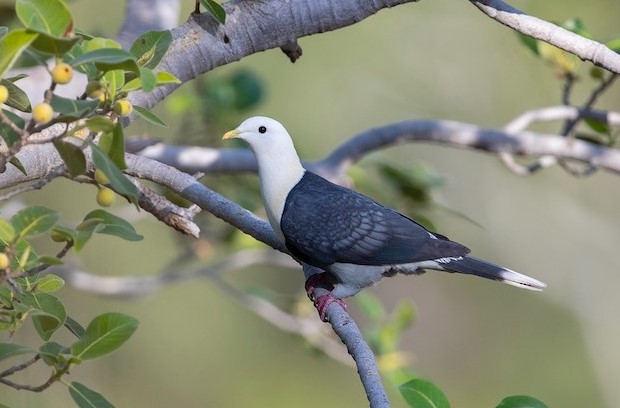The banded fruit dove (Ptilinopus cinctus) was probably more widespread when rainforests covered more of northern Australia than they do now. Compared to other Australian pigeons, it has a more restricted range today. This dove is also known as Black-banded Pigeon, Black-banded Fruit Pigeon, Black-banded Fruit Dove, and Banded Pigeon. The size of the banded fruit-dove is about 320–350 mm in length with a long-tail and 450–570 grams in weight. The dove lays one matt white egg, which is ellipsoidal, about 37 x 26 mm. The call of the banded fruit dove is a loud, clear coo or hoot repeated at short intervals. Low coo during the bowing display.
Arnhem Land’s sandstone escarpments are home to scattered shrubberies and patches of rainforest growing among boulders and in gullies, and it probably doesn’t move much further than a few kilometers from them. Without active protection, the number of this rare bird will decline. The pigeon’s habitat is subject to disturbance by uranium mining, even though a national park includes parts of the escarpment.
A banded fruit dove will usually feed in trees that grow along a cliff edge or at the base of a cliff, alone or in pairs. A tree bearing ripe fruit may occasionally attract groups of 20–30 birds flapping wildly. While banded fruit doves live mostly in trees, they descend to the ground to drink water from soaks where sandstone seeps. For food, they eat wild figs, berries from rainforest trees, and other fruits.
A loud, hooting call is used by the Banded Fruit Dove to announce its territory. The bird calls while holding its body erect, with its tail pointed downward, and pressing its head and bill hard against its inflating throat and breast. Courting males stand upright, inflate their necks and breasts, and then swing their bodies downward slowly at an angle of about 20 degrees above horizontal. The tail hardly moves, and its bill presses against its breast. A low coo is then uttered, and the bird is upright again.
Both sexes are similar. The head is white, while the back and wings are black; the rump and upper tail coverts are pale grey. The upper breast is buff-white; there is a broad black band on the lower breast; and the belly is pale grey. His eyes are red. Bill is grey-green with a yellow tip. The legs are red. Moreover, the immature parts that are white in adults are pale grey with yellow flecks. Those that are dark grey in adults are bronze-green, edged with yellow. Eye deep red with blue surround; bill yellow; toes pink-red, claws black. Also, the downy young are pale grey. Nesting and breeding were recorded April-November. The nest is built of thin sticks arranged in horizontal forks 2.5 to 4 meters above ground, with a diameter of about 250 mm.
There has only been one sighting of the Banded Fruit-Dove in Arnhem Land between Oenpelli and Katherine. There is no information about how far it penetrates the plateau of Arnhem Land to the east. In a narrow band along the escarpment edge, there are probably about two to three pairs per kilometer. Other races live in the Lesser Sunda Islands.
Read More: Rose-crowned Fruit dove (Ptilinopus regina)









